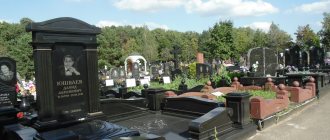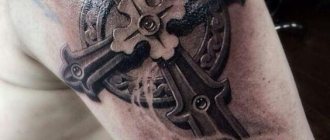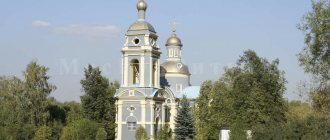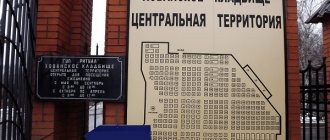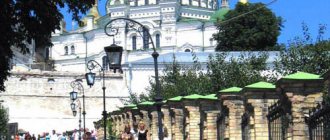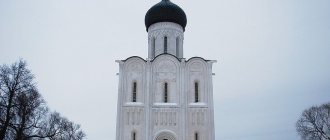The tradition of Christian burial involves placing a cross over the grave immediately after the funeral. Wood is the most accessible and traditional material in Belarus for making such a cross, but along with wooden products, metal ones are also used.
As a rule, a cross placed at a funeral is used temporarily. After about a year, it is replaced with a permanent, permanent monument. At the same time, depending on the chosen design option for the grave site, the metal cross already standing on it can be left at the burial site in a single complex with the monument. In addition, a cast or forged cross that is especially resistant to corrosion is often ordered as an independent memorial sign or included in a memorial burial ensemble.
Dimensions of the cross for the grave
According to church canons, the Orthodox tombstone cross is made eight-pointed, the height of a person. Dimensions are allowed to be reduced, but the proportions of the “Divine Section” must be respected. If, according to Phidias (the sculptor who first used the Divine section in the creation of his sculptures), this figure is 1.618 m, it means:
- The length of the middle bar is Фх61.8=1 m.
- The length of the top bar and the distance from the top of the cross to the middle bar is equal to Ф-2=0.382m.
- Distance from the top bar to the middle F-3 = 0.236 m.
- Distance from the top to the top bar F-4 = 0.146 m.
- Angle of miter bar = 45 degrees.
- Distance from the oblique plank to the base Фх1/2=0.5 m.
If the height of the cross is reduced, all dimensions of the transverse planks, as well as the distances between them, the base and the top, are reduced according to proportion. The sign is hung in the upper third.
The oblique bar at the foot symbolizes the scales of justice. The Bible says that two sinners were crucified with Jesus on Calvary. The one on the right repented and received forgiveness. This is indicated by the right end of the bar lowered down, as if symbolizing the preponderance of the scales in his direction.
The church allows the installation of eight-pointed crosses with a height of 400 - 1200 mm at burials, depending on the size of the burial.
Differences between the Orthodox cross.
In shape and size they are similar to each other, but in the image of the crucified Christ there are some differences. Orthodox tradition says that the feet of our Savior were nailed with two nails. And the Catholic one indicates that only one nail was used during the crucifixion. There are some other differences as well. For example, the shape of an Orthodox cross is most often eight-pointed or six-pointed. In the cemetery, Christian believers have mostly wooden grave crosses. In this way, they perpetuate the memory of the deceased. In the Orthodox faith, it is allowed to use the image of Jesus Christ on a wooden product. On the grave of the deceased, it must be installed in the correct direction, this means being at the feet of the deceased person, and his crucifix in front of his face.
Forged crosses on the grave
Forging is considered one of the ancient crafts, which, although it has undergone significant changes, remains popular today. Craftsmen use new alloys, technologies, and tools in their work. The cost of the work depends on the technique used.
Hand forged
Any work begins with a sketch. A blacksmith leans on it, holding a hammer in his hands. It will take a lot of effort and time until an ordinary piece of iron turns into a unique work of art. In the hands of a master, forged crosses acquire intricate patterns and weaves reminiscent of fine lace. Naturally, handmade products are much more expensive.
Mechanical forging
Mechanical forging is carried out with pneumatic (or hydraulic) hammers. Cold forging of the cross - using special machines that allow you to accurately observe the dimensions. Products made in this way are of high quality and affordable, however, they do not have a variety of patterns.
Stamping
When stamping, the material is clamped on all sides by a press with a given shape. The result is a finished product, which, if desired, can be decorated with additional elements. Its cost depends on the complexity of the decoration.
Finally, anti-corrosion compounds are applied to the iron crosses. Conscientious manufacturers carry out three-layer powder painting and provide a guarantee of up to 5 years.
When rust appears, metal crosses are covered with protective agents. Unlike metal ones, products made from gabbro-diabase (a type of granite) retain their original appearance for a long time and do not require special care.
Is it possible to replace a rotten or broken cross?
If the crucifix has become unusable, it is replaced with a new one. In this case, the wooden product must be burned.
If it is made of a different material, there are three options:
- give to those who do not have the money to order their own;
- divide into parts and bury next to the burial;
- take it to a chapel or temple;
- leave it within the cemetery near the fence.
Taking a crucifix home, using it for household needs, or throwing away the traditions of Orthodoxy is not directly prohibited, but such treatment of the symbol of faith is condemned.
Crosses made of profile pipe
Tombstone crosses are made from different materials: steel, cast iron, iron coated with titanium - there are many options. If a cross is erected on a grave from profile pipes, they adhere to the rules of the “Divine Section”. You can make such tombstones yourself, using a grinder and a welding machine; just select a pipe of the appropriate profile.
They preliminarily calculate the dimensions of the planks and make a drawing according to which they work. The metal cross is quite laconic and has clear shapes. Such a performance is welcomed by the church, as it shows the modesty and repentance of the deceased. Sometimes it is lightly decorated with a pattern of metal plates or wire (6 mm in diameter).
Before installation, the metal grave cross is coated with paint that protects against rust. They try to apply it so that there are no unpainted areas left. To make the coating last longer, it is additionally treated with anti-corrosion varnish.
To cover metal monuments, it is good to use an anti-rust solution.
Materials for production
It is necessary to decide what the grave crucifix will be made of. The entire subsequent process of preparation, and then the actual manufacturing of the product, primarily depends on this.
The most popular materials in our case are wood, metal and stone.
The easiest way is to make a wooden cross yourself. To get a correct and beautiful frame of the model, you will need basic carpentry skills.
If you then want to decorate the almost finished product with carvings, you will also need artistic abilities. At the very end of the work, the wood must be treated with stain and varnished to protect it from the negative effects of the environment.
Metal is a less malleable material than wood and requires very special skills and approaches.
At the same time, it is no less suitable for artistic processing. A skilled craftsman is able to produce very beautiful things from it. The most common method of making a metal grave cross is forging.
When making a grave cross, it is necessary to pay attention not only to the size it will have, but also not to forget about Orthodox traditions. Many customers do not understand how to distinguish Catholic from Orthodox. It all depends on religion. It is customary to use grave crosses made of valuable wood. In order for them to serve for a long time, you need to follow the manufacturing technology of the product. Under no circumstances should you use bad or damp wood, and it is also necessary to take into account the processing of the finished structure.
Stainless steel crosses
Ritual monuments made of stainless steel have strict forms, since the material is difficult to forge and it is difficult to make any patterns on it. Due to the chemical composition included in the base of stainless steel, the product may have a bluish or orange tint. Its mirror surface reflects the environment: greenery, sky. The sun's rays falling on its elements leave shining reflections.
Stainless steel crosses are not afraid of weather conditions, temperature changes, they are not susceptible to corrosion, and have a smooth surface that does not absorb moisture. The only drawback is the high price, since the material belongs to the category of non-ferrous metals.
When choosing a stainless steel monument, you should pay special attention to its cost. If it is low, this should raise suspicions among the customer. Perhaps this is a fake with chrome plating.
Stainless steel products do not require a protective coating.
What kind of crosses do Old Believers put up?
If the deceased was an Old Believer, an eight-pointed, ancient cross is installed on his grave. It is he who denotes belonging to this branch of Christianity.
The second version of the Old Believer funeral symbol is cabbage roll (cabbage roll). This is a cross with a “roof” on top. In the early tradition - a column with a small house or “roof”. It was believed that this is a refuge in which the soul rests in peace and security.
Cross cabbage roll (golubets)
Rules for installing a cross on a grave
The New Testament says that the savior will resurrect and rise, like lightning, from the east, therefore tombstones are installed at the feet of the deceased so that the deceased can contemplate the crucifixion and trust in prayers to the Lord.
Both monuments and iron crosses are placed on graves no earlier than a year after the funeral, so that the earth has time to settle and compact. For a durable installation, the cross must be firmly fixed in the ground, so they resort to either concreting the recess or welding supporting metal slats to the base. The slats are welded both vertically and horizontally. For greater stability, they are placed in the shape of a cross, connecting the ends with additional strips.
Having dug a hole of the required depth and width, place a cross with a support in it. Make sure that it stands strictly vertically. It is most convenient to fill the hole with clay mixed with gravel and compact it well. Clay has good viscosity; in the event of heavy and prolonged rains, it will not be washed out of the soil. After some time, you will have to refill the installation site with earth and compact it again.
Concreting is a more reliable way to install a tombstone. After the concrete has bonded, soil is poured into the recess and the soil is compacted. This arrangement does not cause severe shrinkage.
It is recommended to burn old wooden crosses, in place of which permanent tombstones are installed, the ashes are usually scattered over the grave, or the old cross can be placed behind the monument; over time, the wood will rot and nothing will remain of it.
Priests recommend installing laconic monuments on graves, without frills. Metal tombstone crosses best meet these requirements. They express grief and humility and allow a modest, but rather noble, memorial to perpetuate the burial site.
Advantages of a wooden product.
The most affordable and optimal option is considered to be a grave Orthodox cross made of wood. Only valuable tree species are used for its production. Wood is mainly obtained from aspen, bog oak, pine, cypress, and iroko. In the modern world, there are a variety of designs for graves and the choice can be made based on the one that is affordable and appealing to you.
If you decide to install a cross on the grave yourself, then first you will need to understand some details. Before installation and preparation, you need to decide on the material that you will use. To a greater extent, the entire installation and preparation process will depend on it. The most popular are three types of gravestones: wood, metal and stone.

